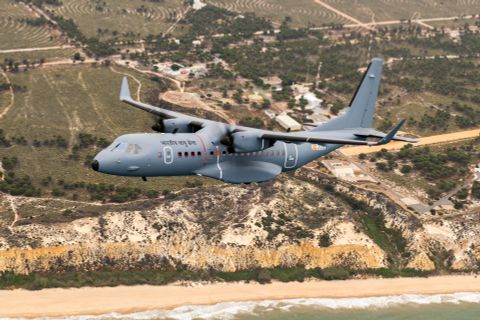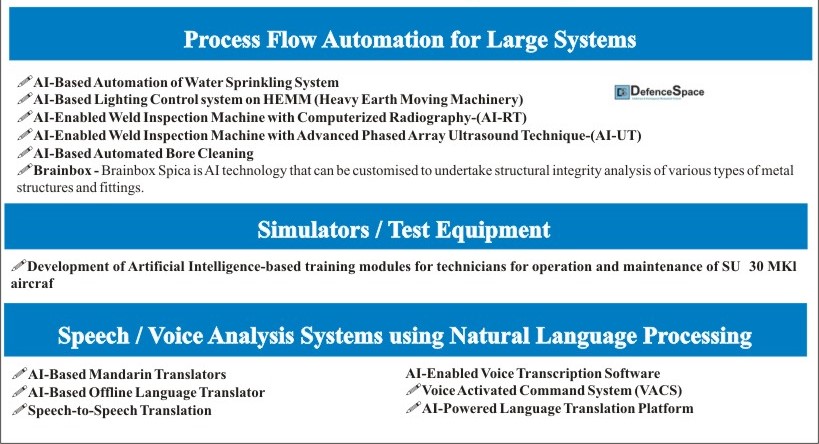BY RITIKA BEHAL
In the Part-1 of the Blog Post - we had covered the airborne disruptive technologies - Artificial Intelligence, Robotics, Autonomous Unmanned System, Cyber Capabilities, and the capability and development of these technologies globally and also with regards to the Indian Air Force.
Taking further, in this Part - II of the BLOG POST we will be covering the remaining disruptive technologies.
Countering Unmanned Aerial Vehicle (UAV)/Drone System Technology
This is yet one more emerging airborne based disruptive technology which is slowly gaining momentum keeping in mind the increasing usage and threat arising from UAVs/Drones by Air Forces world over.
A complete and effective Counter UAV system must be capable of timely identifying/detecting, tracking as well as intercepting/neutralizing these risks arising from UAV/Drone usage.
Rather, in coming years the need to alleviate the risks of UAVs will call out for increasing adoption of ‘Counter UAV/Drones technology’ by countries globally.
Countries like US, China, Europe, Germany, France, Italy and Russia are already leading the race in developing of this technology.
Noteworthy, as the requirement of UAVs grows up, concerns would also grow around the potential security threats leading to the requirement of (induction and manufacturing) of counter-drone technologies.
In the Indian context, the country has just embarked its journey with experimenting of Counter UAV/Drone technologies for the Indian Air Force, however, these technologies are still very nascent and there is a long way to go in manufacturing them indigenously.
In 2018 the Government invited a number of local and foreign players to exhibit their technologies in this vital area so that appropriate mechanisms can be put in place to counter the threat of rogue drones.
IAF along with a number of Government agencies such as Ministry of Civil Aviation, Pawan Hans Limited, CISF, NSG, DRDO etc. participated in the process along with local and foreign firms to decide on the technology best suited under Indian conditions.
As of now, the DRDO labs and Bureau of Police Research and Development (BPR&D) are already taking up Counter UAV related R&D and technology aggregation projects.
Also, to be noted that DPSU Bharat Electronics Limited (BEL) has developed a Drone Guard System (DGS) which can detect, track and neutralise the intruding drones. The System utilises RF spectrum to detect the drone and EO-IR sensor to track the drone continuously.
As of now, the Indian market for these Counter UAV systems is somewhere around $4-5 Million (Over Rs 250-300 Crores). However, there would be a growing requirement for Counter UAV system owing to the growing demand of UAVs seen with the IAF.
Directed Energy Weapons (DEWs)
DEWs are visualised as a revolutionary technology with the world gradually pursuing them. These are basically ranged weapon that damages its target with highly focused energy, including millimetre waves, lasers, microwaves, electromagnetic pulses and particle beams.
Potential applications of this technology include weapons that target personnel, missiles, vehicles, and optical devices.
However, Directed Energy Weapons are still at the experimental stage and as of now only US, Russia, China, UK and India are known to be developing these, and some have already employed them in their militaries.
Moreover, China, is not only developing laser weapons but also working on countermeasures to elude them.
India has undertaken indigenous development of air based Directed Energy Weapons for the Indian Air Force but it is at a nascent stage and a lot of experiments are being conducted.
The Indian R&D entity DRDO has been working in this area for the last 3-4 years to develop 10-kW and 20-kW weapons for the Air Force.
Rather, last year DRDO successfully tested a 1KW laser weapon that hit a target 250 meters away.
DRDO has also initiated a project called Directionally Unrestricted Ray-Gun Array (DURGA) II, which aims to develop a 100-kilowatt lightweight DEW.
Both DRDO and Indian Space Research Organization (ISRO) have developed and tested hypersonic technology in India. DRDO successfully tested the Hypersonic Technology Demonstrator Vehicle (HSTDV) in 2021, which can travel at six times the speed of sound.
India is working on developing an indigenous hypersonic cruise missile that is capable of carrying both conventional and nuclear payloads. This missile is being developed as part of India’s Hypersonic Technology Demonstrator Vehicle Programme.
Bottom-Line
The new and emerging trend of airborne based disruptive technologies in most likelihood will be the most important determinants of defensive and offensive capabilities for aerial warfare in future, and thus rightly regarded as a game changer in modern day war-fighting.
Moreover, these technologies are the future and would become even more critical and also complex in nature in years to come with their potential spin-offs or emergence of more such niche technologies.
Keeping this in mind the IAF has started taking steps towards developing and equipping itself with these technologies.
However, most of these disruptive technologies are under development or lagging behind as compared to the other current developed technologies of the same genre by some of the other countries.
The next generation warfare will be more and more technology driven, automated and robotised and so IAF needs to be prepared.
Thus, there is an urgent need in investing heavily in these technologies which will indeed help the IAF in gaining the technological edge.
For this, the Government should come ahead and support development of such disruptive innovative technologies and should provide the necessary policy framework and incentives, including direct funding to select companies, start-ups and research institutions.
Also, the Government through consultation with the Indian Air Force and all the other stakeholders should identify what all new emerging disruptive aerial-based technologies can be developed and inducted in future.
Further, these should be particularly need-based and of course most importantly affordable. For this, it is essential to understand the needs of Indian Air Force and exactly what disruptive technologies they want.
Accordingly, it is also important to effectively understand and manage such new technologies by identifying their strategic and tactical efficacy/utility in existing defence spectrum, the possible contributions and benefaction they could make towards improvising overall competence of the IAF.
Furthermore, India should access such disruptive technologies available with all centre of excellence available in India like DRSO, CSIR, BARC, ISRO and private sector and see how these can be collectively used to develop such technologies for Armed Forces including of Indian Air Force.
If India really wants to become a technology leader, then the Government should put impetus on clearly laying down the roadmap for current and futuristic airborne based technologies to be acquired by the Indian Air Force.
Along with this, the government should also provide coupled with providing requisite funding while also working in a fast paced manner towards those technologies; or else, it will merely remain as a technology follower.




